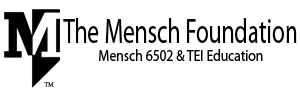The William D. (Bill) Mensch, Jr. Best Use of Embedded Intelligence Innovation Award
Given at The UArizona College of Engineering on Design Day
Description: The Mensch Prize for Innovation recognizes the engineering team that best integrates embedded intelligence into a potential commercial product that was developed in a senior design project. Specifically, the award will be granted to a student team that has built a smart connected prototype that may have a commercial market. Embedded Intelligence as explained in The Theory of Embedded Intelligence (EI) is characterized as the ability of a product to sense, process, communicate, and actuate (SPCA). SPCA is a foundation of understanding for engineering a beneficial outcome.
Background: Embedded Intelligence Technology (EIT) is defined and used here to include the combination of software and microprocessor hardware used in Industry 4.0, Embedded Systems, Intelligent Systems, and/or characterized as having Artificial Intelligence (AI). Application-specific EIT is used in a wide range of solutions in products like microwave ovens, refrigerators, pacemakers, smartphones, automobiles, robots, drones, and airplanes. The most common feature of these products, which fall into the category of “Internet of Things (IoT),” is that they communicate with each other (increasingly through what is described as “cloud services,” which constitutes a higher level of intelligence). Visit The Bill and Dianne Mensch Foundation, Inc. website at TheMenschFoundation.org to gain a better understanding of Computer Science and Engineering (CSE) concepts associated with The Theory of Embedded Intelligence (EI) and EIT.
CAUTION: As with the study of Consciousness, the study and application of Embedded Intelligence (EI) could change one’s life.
Self-Nomination Requirements: Self-nomination is done through the Engineering Design Project Management (EDPM) system. Below is the introduction and questions that can be found in EDPM:
Embedded Intelligence is characterized as the ability of a product to sense, process, communicate, and actuate (SPCA) based upon information gained from an understanding of both itself and others and for the benefit of many. Provide justification in the space below for how your project deserves to win this award (two pages max).
The use of the word “nature” herein mean the particular combination of qualities belonging to a person, animal, thing, or class by birth, origin or constitution, native or inherent character.
Please make sure to answer the following questions:
1.) Was something sensed (S)? Yes _ No _ What was sensed in 25 words or less?
2.) Was what was sensed processed (P)? Yes _ No _ What was and the nature of the process in 25 words or less? Was there a calculation/mathematics involved? Yes _ No _
3.) Was something communicated (C)? Yes _ No _ What was communicated and the nature of the communications in 25 words or less? Was a radio involved? Yes _ No _
4.) Was something actuated (A)? Yes _ No _ What was actuated and the nature of the actuation in 25 words or less? Was something turned on/off? Yes _ No _
5.) Does your project’s SPCA capabilities demonstrably surpass human abilities? Yes _ No _ What does it do and how does it surpass human abilities in 25 words or less?
6.) Was your project innovative? Yes _ No _ What was innovative about the project described in 25 words or less? What is the “guesstimated” innovation value of this project to mankind? Value greater than $1M _ Value greater than $100M _ Value greater than $1B _ Priceless _
7) Do you plan to create or join a business to further the value of the innovation in the service to mankind? Yes _ No _ Do you have a business plan? Yes _ No _
8) Do you have a picture of your innovation? Yes _ No _ Please provide if your answer is yes.
Prize: Prize amount is $1,000. The amount may be reevaluated based on the available Payout from the endowment.
2025 Award Winner
Team #25033 MD-Sensei – The MD-Sensei (MD-S) platform is an advanced AI-driven solution acting as a Digital Clinical Mentor to deliver concise, situationally relevant,
real-life clinical guidance to Healthcare Workers (HCWs) in the developing world, at point-of-care, in real-time, and on-demand.
AI in Healthcare Article 2025 Engineering Design Day Article
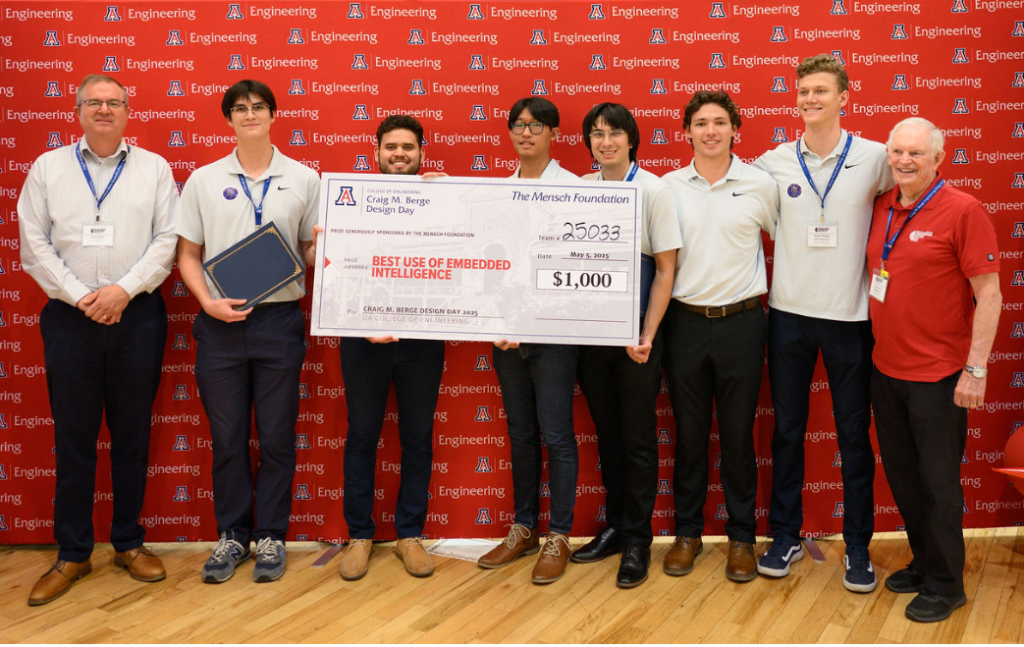
2024 Award Winner
Team #24067 Small Item Photographing Triage Robot (SIPhTR)
Read more about this project on their Capstone Project Page.
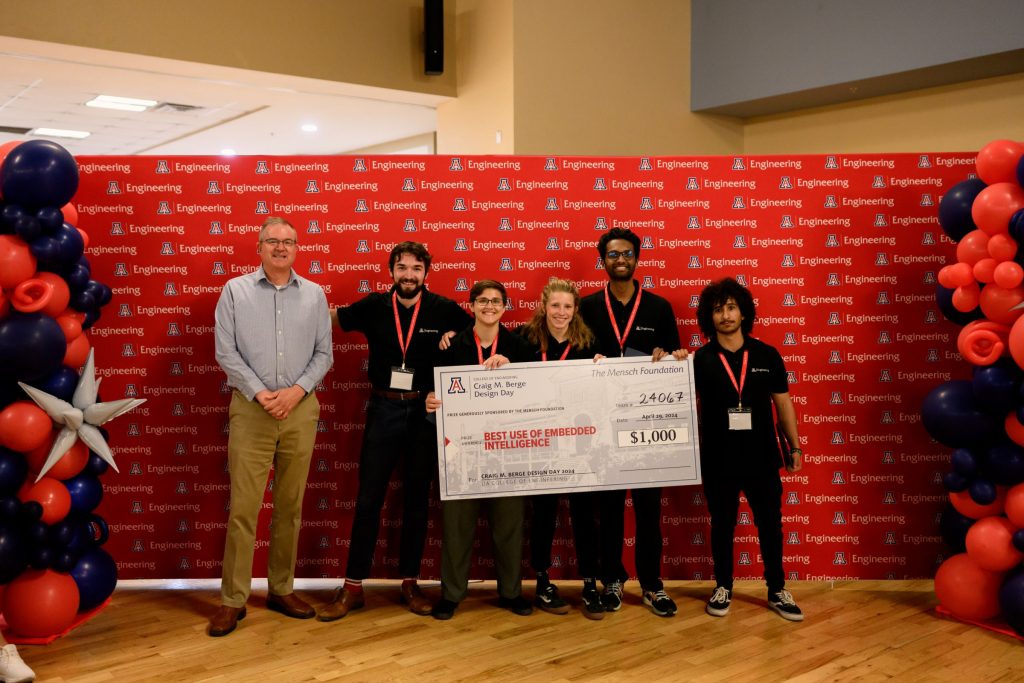
2023 Award Winner
Team #23088 Supplement Recommending Mobile App w/ Handheld Measuring Device for Saliva pH and Calcium Levels.
Read more about this project on the Capstone Project page.
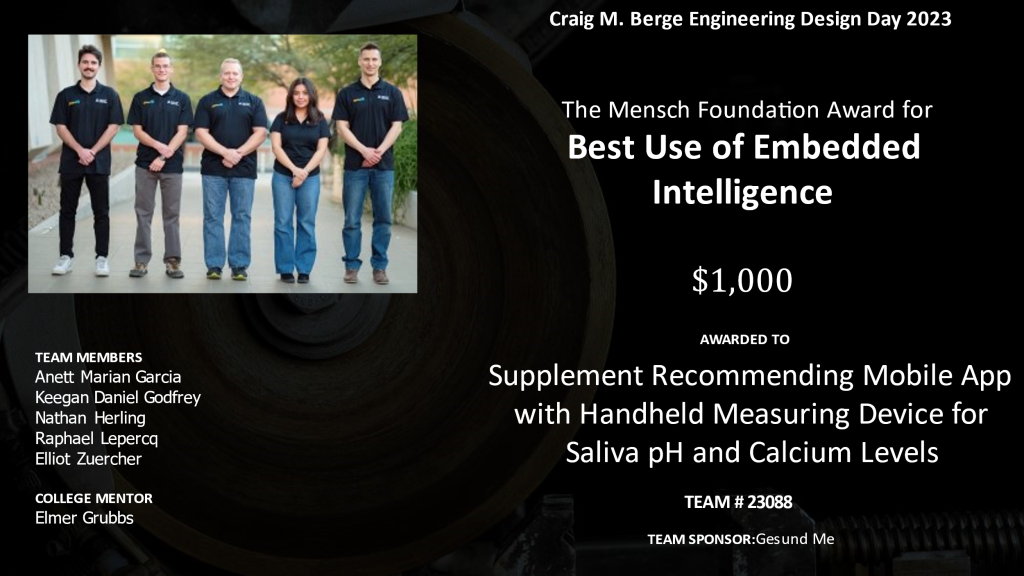
2022 Award Winner
Team #22026 A Realtime Vegetation Stress Detection System on a Drone
Read more about this project on the Capstone Project page.
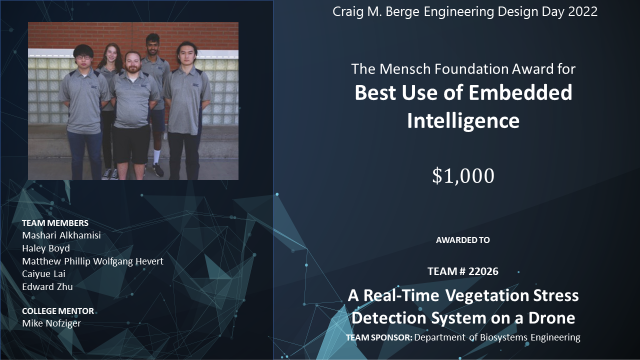
2021 Award Winner
Team #21014 Advanced Hospital Bed System
Project Description: This project resolves the formation of pressure ulcers (bed sores) which are expensive to treat. Bedsores are a recurring problem for immobile patients and often lead to infection, necrosis, and other complications which are resource and cost-intensive to address.
Click here for Team #21014 Biography
2020 Award Winner
Team #19094 Biosphere 2 Controlled Systems Monitors
Project Description: To design and build real-time, low-cost, high precision, and high accuracy environmental monitoring systems for two controlled environments at The University of Arizona Biosphere 2 which demonstrate both aquatic and terrestrial applications of embedded sensor systems.
Click here for Team #19094 Biography
2019 Award Winner
Team #18055 Unmanned Aircraft Ground Control System for Automated Date Pollinator
Project Description: The system, designed in collaboration, controls an unmanned aircraft as it flies through a date palm plantation and pollinates the palms. The computational system mounted on the aircraft uses computer vision and artificial intelligence to observe, model and act on its environment to efficiently and safely complete the pollination process. This includes the identification of the palm trees, the command to release pollen, and the detection and avoidance of obstacles. The system provides the date farmers with a modular product capable of pollinating a field of date palm trees in an industrial-scale farming environment. This allows for significant savings by reducing labor costs and the risk of injury during manual pollination.
